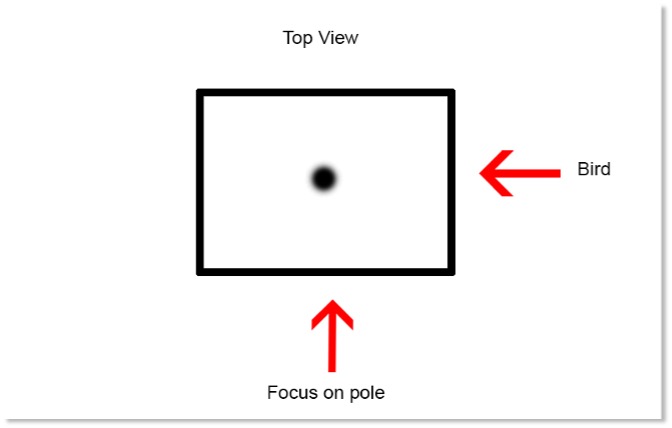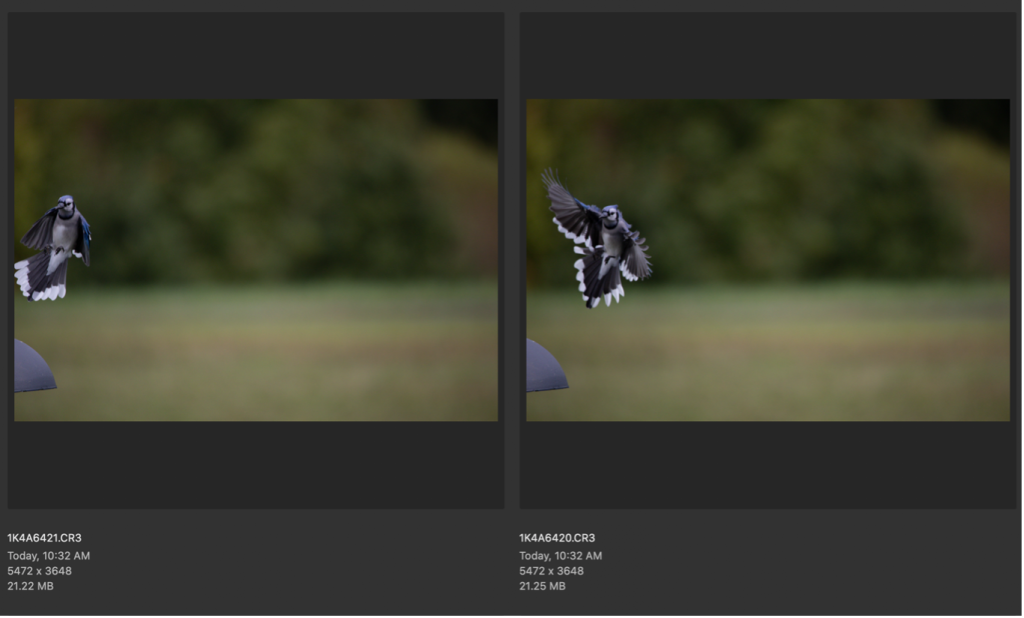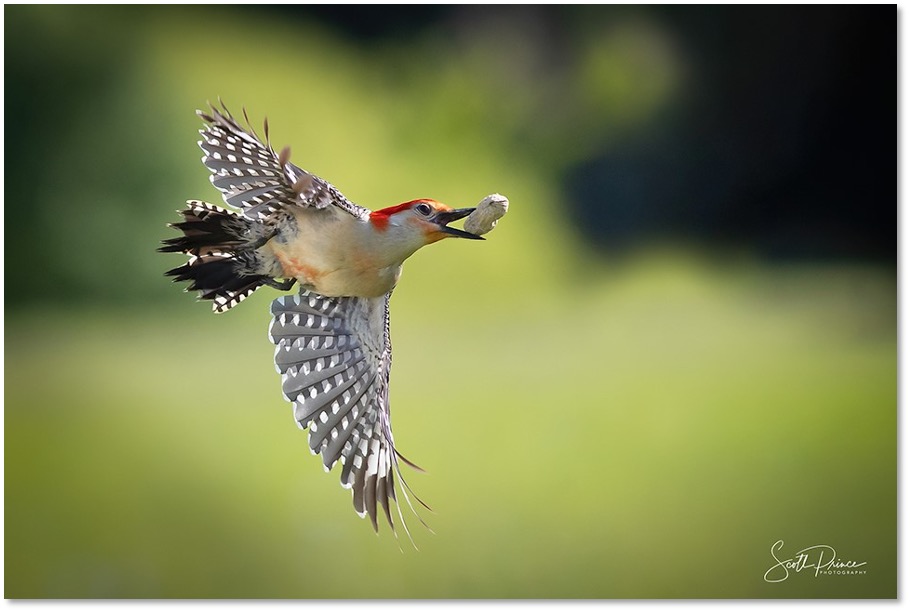
NOTE: This method works best with birds flying in from the side of the feeder.
Platform feeders are the best way to attract larger birds like Woodpeckers, Blue jays, Cardinals etc. These feeders are also the best way to capture birds in flight in my opinion. I currently have two techniques using the platform feeder. Try them both and decide which one gives you the most keepers.
Unlike the tube feeders, platform feeders offer more room and the ability to utilize a variety of seeds. It’s not unusual to see a large variety of bigger birds on this feeder.
Platform feeders are a bit more challenging when capturing birds in flight due to the size, largely because there is more real estate for the birds to land on, unlike the tube feeder. When using a platform feeder, you will need to study where different species of birds land and take off. for Instance, the Red Bellied Woodpecker will come in low and swoop upwards and then land on the feeder so I know not only do I have to turn my camera, I also have to aim more towards the ground to get that awesome full wing spread.
SECRET: The smaller the platform feeder the better your odds of getting a bird in focus because the smaller feeder brings the bird closer to the platform feeder support pole, which we manually focus on.
Cardinals in my yard fly from the woods, to my weeping willow tree, and then onto a rose bush near the feeder, then they land on the side of the feeder. I can pretty much predict the flight path and set up my camera accordingly.
When using a platform feeder to capture birds in flight, there is no way to restrict where they will land but you can through proper placement, line the feeder up within a flight pattern. For instance, if the birds land on a fence on one side of your yard, they will probably leave the fence and land on the same side of the feeder. So, you should set up your camera towards the side facing the fence.
It’s important not to get a large section of the feeder in the photo because that’s more cropping you’ll have to do. Keep in mind we only want a shot of an isolated bird with a nice wing pose.
There are several ways to mount the feeder but I do not recommend the type that hang. I’ve used those and one of the issues I had was it turning or swinging in the wind. We want our feeder to be stable.
I recommend the pole mounted version. I went a bit further and mounted my feeder on a light stand which allows me to move the feeder wherever I want it depending on the sun, the background I want, or the species of birds using the feeder. (Large or small)
As I mentioned earlier, the Cardinals in my yard follow a specific flight path. If I want to photograph a different bird, I may have to move the feeder according to where the bird enters the yard. After a while you’ll begin to notice the different approach areas different species take so you can adjust as needed.
This brings me to another point. When setting up the platform feeder, make sure it’s not too far away, or too close. Too far away, you’ll have to crop the heck out of your images and it will degrade the quality. Too close and parts of the bird will be chopped off in the image. A zoom lens works well in this application.
TIP: Once you get set up on a station, don’t try to chase all the other birds around. Stay focused! (No pun intended)
You can take measurements and duplicate them every time you set up, or simply put something in the ground as a marker for the feeder position. This will keep you from walking back and forth to the feeder moving it 5 mm closer or further away 10 times when taking down and setting up.
So now that the feeder is set up and camera is on a tripod, manually focus on the pole that supports the feeder. I find focusing here gets me the highest keeper rate as most of the birds will land on the middle of one of the side boards, or close to it. See image below.

You have to keep a sharp eye out for the birds as they will come and go before you even get a chance to photograph them, that’s why manual focus is so important.
As a bird approaches the feeder, fire away. Remember it’s easier when using a shutter release. Heres the one I use for my Canon R6. After it leaves, take a look at the images. Do you need to adjust the camera height or move the lens left or right? We need to have the entire bird in the image. Are you getting the cool poses or just the Superman poses?
TIP: Moving the lens left or right, depending on which side you’re shooting from will capture different poses.
What do you think the poses will look like if your lens was pointed heavily at the feeder? I can tell you, most of the poses will be with bird feet sticking out, or the Superman pose, not what we’re after. Until you hone in, you will see images like the ones below.
NOTE: Here is a series of shots in no particular order showing a Blue Jay with different wing poses. If you have a camera that can shoot a high rate of frames, then you’re good to go. If it doesn’t, then you may have to turn your camera to the side a bit to catch the bird as it spreads its wings before it gets to the feeder. This is something you’ll have to experiment with.
I think it’s safe to say a bird will do the wingspan in the same location most of the time.





BONUS SECTION:
If you didn’t get the manual focus in-coming shots in focus, you can quickly place the camera or lens back in auto focus, focus on the bird at the feeder, try to anticipate when it will leave, and take some more shots as it flies away. I’ve actually had really good success using this option and it is now my preferred choose when photographing birds.
Here’s an example. A woodpecker comes to the feeder out of my manual focus zone and gets a peanut in its beak. It looks around for a second or two, and then flies away. I missed the incoming shot because I was on Facebook or Twitter playing around, ok or napping.
I know once it gets a peanut it’s going to leave any second, obvious right? So, what I’ll do next is auto focus on the bird and begin shooting while it’s standing in the feeder. As it flies away, I pan along with it and keep the shutter button down until the bird is gone. Hopefully the bird will exit the feeder on the side and not fly away leaving me with shots of its butt.
Again, shooting flying backyard birds is a numbers game. You may have to take a lot of shots, or, if you’re good or lucky, you’ll get a keeper right away! Here are a few shots using auto focus as the bird leaves the feeder. I received a lot of nice comments on social media for this shot. I know you will receive a lot of awesome comments also when you get these methods down!


